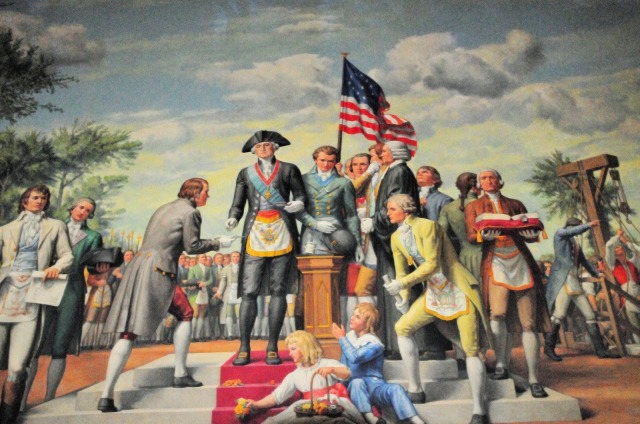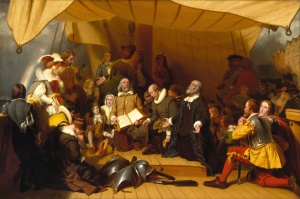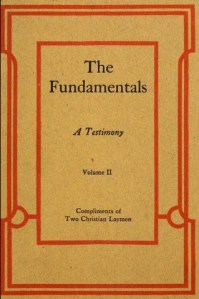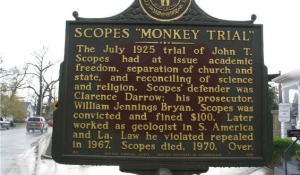 The political climate in America is one of bitter tension and strife. Of the many issues out there inspiring Americans to wage war against each other lately, the one I think about most often is the divide between scientific materialism and fundamentalist Christianity. In my opinion this is the central set of ideas underlying the structure of our nation—i.e., freedom of rational thought, with supreme faith and dependence on God. What’s most perplexing, perhaps, is that both views seem to have a valid argument for laying claim to ideological ownership of this country, but only when taken separately, rather than as a unity. The United States of America is a two-sided enigma—on the one hand we have the powerful separation between church and state, and on the other, the idea of America’s divine providence, that we are “one nation under God, indivisible, with liberty and justice for all.”
The political climate in America is one of bitter tension and strife. Of the many issues out there inspiring Americans to wage war against each other lately, the one I think about most often is the divide between scientific materialism and fundamentalist Christianity. In my opinion this is the central set of ideas underlying the structure of our nation—i.e., freedom of rational thought, with supreme faith and dependence on God. What’s most perplexing, perhaps, is that both views seem to have a valid argument for laying claim to ideological ownership of this country, but only when taken separately, rather than as a unity. The United States of America is a two-sided enigma—on the one hand we have the powerful separation between church and state, and on the other, the idea of America’s divine providence, that we are “one nation under God, indivisible, with liberty and justice for all.”
It isn’t any wonder that confusion and contention have arisen as to what this country stands for, with two ideological beliefs that, at a glance, appear to be diametrically opposed, at the very least in direct conflict. In this brief essay, I’d like to explore how without the inclusion of Freemasonry within the overall political infrastructure of the country, a holistic picture of “true America” cannot and will never be obtained. This is not intended to be fully detailed academic handling of the subject; we have enough of that kind of writing within our fraternity; it is often questionable how much good such writing even does for us; we are not a university or an educational institution, in any regular sense. What I hope to do is shed light on this issue, for the brethren of Freemasonry in particular, and to throw my two cents onto the craps table.
It is our great fraternity that provides the solution and adhesion for the two opposing views—scientific materialism and Christian fundamentalism—which are currently working to tear this country in half. Freemasonry, at the nation’s founding, served to provide a necessary glue that held intact the initial intentions of America. Freemasonry has since been largely evicted of this function. It remains to be seen if it can be brought into service once again in the future, to help mend the nation’s many wounds.
 The first settlers to this country came largely to escape religious persecution. Pilgrims, Calvinists, Puritans and other extreme forms of Protestantism sought the New World in order to flee their oppressive homelands which were dominated by church-controlled regimes that determined the religious doctrine of their citizens. In the case of these settlers, this was the Anglican Church, or Church of England, an institution that was embedded in Britain’s rulering leadership at a national level—the exact opposite of a separation between church and state. Thus, those with new, unique, extreme, or individual ideas about religion (namely, Christianity) wanted freedom to practice their religion and a separation from the English state church. It was under the heading of religious freedom then that the first settlers to America established their colonies. The idea of religious freedom and the prevention of an established national church was written into the United States Constitution and the Bill of Rights.
The first settlers to this country came largely to escape religious persecution. Pilgrims, Calvinists, Puritans and other extreme forms of Protestantism sought the New World in order to flee their oppressive homelands which were dominated by church-controlled regimes that determined the religious doctrine of their citizens. In the case of these settlers, this was the Anglican Church, or Church of England, an institution that was embedded in Britain’s rulering leadership at a national level—the exact opposite of a separation between church and state. Thus, those with new, unique, extreme, or individual ideas about religion (namely, Christianity) wanted freedom to practice their religion and a separation from the English state church. It was under the heading of religious freedom then that the first settlers to America established their colonies. The idea of religious freedom and the prevention of an established national church was written into the United States Constitution and the Bill of Rights.
However, as more and more settlers arrived, the same kind of merging between church and state governance, as practiced in England, started creeping in again, particularly with respect to Anglicans and Baptists, which promoted Thomas Jefferson’s famous letter to the Danbury Baptist Association in 1802, in which he stated:
Believing with you that religion is a matter which lies solely between Man & his God, that he owes account to none other for his faith or his worship, that the legitimate powers of government reach actions only, & not opinions, I contemplate with sovereign reverence that act of the whole American people which declared that their legislature should ‘make no law respecting an establishment of religion, or prohibiting the free exercise thereof,’ thus building a wall of separation between Church and State.
My point here is to show that the first Americans were in no way anti-religious, anti-god, or anything else, but were in fact extremely pious and spiritual individuals. However, they also felt religion could be practiced and experienced in a variety of different, individual ways, and so a division in matters pertaining to religion and government was consciously erected, something that had never before been done. Even from a conservative-rightist perspective, if the country was to go back to its roots—its real roots—this would look like a religious plurality similar to the cultural climate of ancient Rome, rather than one national dominant church of evangelical Christianity overseeing the affairs of the entire country. This latter just simply can never happen, because it is adverse to the foundational tenets of the United States Constitution. What I have come to believe is that fundamentalist Christianity, begun ca. 1910-15 with the publication of The Fundamentals: A Testimony To The Truth, is a direct response to the rise of Enlightenment thinking and scientific materialism, both of which were also present in the establishment of our country (along with religious freedom).
The Fundamentals: A Testimony To The Truth, is a direct response to the rise of Enlightenment thinking and scientific materialism, both of which were also present in the establishment of our country (along with religious freedom).
Given the exceptional free reign in America due to the separation of church and state, as well as the Enlightenment ideals prevalent among the Founding Fathers, the practice and proliferation of rational thinking was widespread. People like Benjamin Franklin and Thomas Jefferson were all for the progressive development of the country along industrial and technological lines, and they aided in this process, along with the promotion of capitalist economics. New scientific discoveries and ideas, most importantly Darwin’s theory of evolution and steam engine technology, were imported wholesale into the United States and welcomed and assimilated into the cultural milieu.
All this resulted, overtime, in great advances in science, education, and government policy, the likes of which the world had never seen, and with the passing years the United States trundled toward the world of modernity. And yet a large percentage of the country continued to practice its unique array of faiths, with outdoor baptisms and spiritual revivals increasing in popularity.
These two elements of American culture appeared to be moving forward harmoniously, but the problem with widespread rational scientific thinking that basis reality only on empirical evidence is that eventually people start doubting the existence of an invisible, divine realm. And that’s just what started happening to many 19th century and early 20th century Americans.  Tensions began to make themselves known, which culminated in 1925 with the Scopes Trial and the banning of the Bible from American classrooms for good.
Tensions began to make themselves known, which culminated in 1925 with the Scopes Trial and the banning of the Bible from American classrooms for good.
Since then, we can literally track through history these two divided camps of citizenry as they continued both to separate and grow more extreme in their thinking and beliefs. What I believe is that these two camps have become the modern day Democratic and Republican political parties (in terms of ideologies), the liberal rational and the fundamentalist religious, respectively. Of course, this is a generality of the two parties, but I make this generality in order to present the clearest, most understandable picture. Although the issues currently debated across the country at the present time range from sexual orientation to certain acceptable flags to abortion, etc., I believe that at bottom the two camps who battle one side or the other on these issues are direct descendants of the church and state, religious plurality, and Enlightenment thinking trinity that was written into the United States Constitution.
So where do we go from here?
This is where Freemasonry enters the frame. Freemasonry is the place where a) religion and science join forces, and b) where all religions can be practiced side by side in universal brotherhood. There is even a democratic governmental structure within Freemasonry, on which the US government is also based. Unarguably, many of the men who established the government in this country were Freemasons. Most people know this. Additionally, many of the men who have worked through history to promote these constitutional ideas have been Freemasons.
Why such a connection?
For several reasons, the most important being that the United States, when compared to Freemasonry, seems almost to be modeled entirely after the fraternity, and if not fully, than at least to a large degree. The governmental and democratic methods, already mentioned, are very similar in both their bureaucratic and judicial methodologies.
Furthermore, the spiritual climate in Freemasonry is one that promotes religious freedom: all major religious texts are to be present on the altar,  the name of God is changed to the more neutral Great Architect of the Universe, and esoterically minded individuals can pray alongside exoteric traditionalists.
the name of God is changed to the more neutral Great Architect of the Universe, and esoterically minded individuals can pray alongside exoteric traditionalists.
This is possibly the kind of environment that was envisioned by the Founding Fathers when they wrote the First Amendment, not only for Western religions (although Christianity takes the lead), but for Eastern ones as well. Take the following example: During the late 18th and all through the 19th century there was an explosion of interest in Eastern religions such as Buddhism and Brahmanism across the country, which continues to this day. America, perhaps more than other countries, seemed equipped to accommodate, not only the many unique variants of Christianity, but also the Eastern religions as well, so that all could be practiced side by side. My argument is that this was possible because the United States itself was consciously modeled like a gigantic Freemasonic lodge room.
And finally, there is the question of rationalism and material science, both of which have their place in Freemasonry, where the brethren are admonished to make the study of geometry their primary pursuit. The brethren are also admonished to study nature and the physical sciences. The main difference, however, is that the Freemason is enjoined to take up these pursuits with a spiritual reverence for the GAOTU. To study the world of nature is to study the Creator, and this is the crucial element that has gone missing from the university sciences, who conduct the same pursuits without any reverence for a divine creator.  In Masonry, because science and reason are approached in this way—as a divine, esoteric, reverential practice—they can exist alongside the religious without evoking the terrible split that has overtaken the country at present, namely the divide of scientific materialism and evangelical fundamentalism. Perhaps this ideal is not always achieved in the fraternity; there are always problems; but certainly Masonry, when practiced as intended, will produce this condition every time.
In Masonry, because science and reason are approached in this way—as a divine, esoteric, reverential practice—they can exist alongside the religious without evoking the terrible split that has overtaken the country at present, namely the divide of scientific materialism and evangelical fundamentalism. Perhaps this ideal is not always achieved in the fraternity; there are always problems; but certainly Masonry, when practiced as intended, will produce this condition every time.
To conclude, from this brief survey we can see the similarities between what America was intended to be, and what Freemasonry can be when practiced correctly. The two seem to fit together perfectly, and when they are fitted together as such, they seem to offer a potential solution for the problems working to divide our nation. Add to this the fact that the Founding Fathers were active Freemasons while establishing the foundation of this country and while holding office. Clearly, the fraternity was an important part of their reality, and the reality underlying the United States at that time. And things, arguably, ran a lot smoother then.
But times have changed, the world and its people have evolved, and Freemasonry has been to some extent left behind as the country marches forward. But by looking at the issues and the intense hatred projected by Americans on either side of the left and right political divide toward their fellow citizens in the present day, we might wonder if Freemasonry has a larger role to play in America than is often thought. And if so, is it even possible to reintegrate some of what we have lost with the decline of Freemasonic America, or is it too late, and are we all headed for another civil war? Only time will tell.

Great post. Of course, the next question must be, “Exactly what might ‘a greater role [for Freemasonry] in America’ actually be, in concrete terms?”
LikeLiked by 1 person
Thank you for reading, Bro. Mark! Yes, that would seem to be the next question. I feel there is a certain “mentation” that can be achieved by people, first and foremostly, which is similar to the mentation men achieve by becoming active Freemasons. That’s a sort of preparatory mental, ideological step. But then there is the practical application, in more concrete terms, of how the Freemasonic lodge climate and approach can be integrated and utilized within America at a more foundational level, and that is a question which will take a lot of work and great care, but I do believe something could be come up with.
LikeLike
I applaud your efforts and thinking on the topic. You have obviously put a great deal of effort and thought into the subject matter. Idealistically, I agree; however, history is replete is examples of religious zealots who desire only to control spiritual doctrine, and have gone to great lengths to destroy the mysteries. I am satisfied with our current position as an institution of spiritual learning and self discovery; if we attempt any other type of immersion, I honestly think we might lose our status as an honorable institution. I look forward to reading your posts in the future ~/G\~
LikeLiked by 1 person
Thanks for reading the blog, Bro. Hank! I definitely see your point and can sympathize. I think it may be enough for some aspects of the “mindset” of Freemasonry to be re-introduced into American culture rather than an actual fusing together of the Masonic fraternity and the US Government. But you are right to be wary of ‘religious zealots who desire only to control spiritual doctrine’; in fact, this is just what Freemasonry serves to inhibit, in my opinion, which American citizens, politics, and culture could most benefit from, as we also strive to throw off oppressive scientific materialism.
LikeLiked by 1 person
Freemasonry is the one institution that teaches, if not preaches, reconciliation of differing ideas within a broader intellectual context, rather than the, traditional, parochial and self-centered ideological one. Hence, the ability of the Founding “Brethren” of this nation to complete carry out their task. How can we, “moderns”, carry Out our task? By being pillars of our communities. By becoming active in the civic arena, if not the political, and practicing outside our Lodges those virtue inculcated therein. Our nation faces no problems which cannot be solved by an added measure of Freemasonry.
LikeLiked by 1 person
Indeed! SMIB!
LikeLike
Excellent article, and this is exactly what I have taken from AASR teachings; less so in Blue Lodge. I didn’t understand the nature of a free Republic until I became a Scottish Rite Mason. Unfortunately, I see Masons go through the degrees and go right back to the fanaticism they swore to war against. The change that comes through Masonry has to happen in the individual level, and from there collective change would be the natural product. That said, the reins of Freemasonry have been taken over in many regards by one side of the divide in the US, and the other side of the divide in certain European and Latin countries. We need to heal the fraternity before we can heal the country through the fraternity. We are in dark times, and dark times are not new to humanity. However, the has always been a mystery school to protect the fire while the winds of darkness blow hard around us.
LikeLiked by 1 person
Thanks for reading, Sieur Chevalier Tixerand! And I agree very much with what you write here, that the fraternity itself needs to be healed before it could be utilized in the way I am describing in the article. Healing the fraternity is quite a project in and of itself, but I feel like we’re slowly moving in the right direction (I hope).
LikeLike
Outstanding post.
LikeLiked by 1 person
Thank you for reading!
LikeLike
Thankyou Bro: for Creating this page. Sharelling the #MasonryKNOWLEDGE from history to #EDUCATE the #COMMUNITY
Congratulation for the #AWESOME work you’ve done.
LikeLiked by 1 person